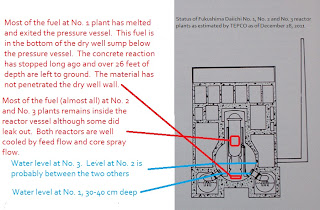A significant fire has occurred involving a Delta IV class ballistic missile submarine, the 'Yekatarinburg,' while in a large floating drydock at the port of Roslyakova.
This class of submarine is reportedly powered by two 90 MWt two-loop pressurized water reactors. The Russian Navy reports that the reactors were shut down (and I'm sure they were before the floating dry dock was raised) and that no damage has occurred. No weapons were on board the submarine.
Reports indicate that non-compliance with maintenance procedures in the dry dock probably caused the fire. The fire may have involved anechoic coating on the submarine exterior. The floating dry dock was partially lowered (submerged) to help stop the fire. The fire was apparently entirely external to the submarine. Reports of injuries are mixed, and unclear.
A number of good reports are out on this event, and I'll link these below.
BARENTS OBSERVER on submarine maintenance fire
AFP via Google report on submarine maintenance fire
FAS.ORG data brief on Delta IV class SSBN
Amateur raw video of the fire in progress
There is also an AP report on this 'favorited' at the APR YouTube Channel.
As of this moment, rather expectedly, nuclear impact is zero. Unless the seawater supply hoses to the boat were severed or seawater cut off, there would be no impact to reactor cooling.
11:30 PM Eastern Thursday December 29, 2011
ATOMIC POWER REVIEW
This class of submarine is reportedly powered by two 90 MWt two-loop pressurized water reactors. The Russian Navy reports that the reactors were shut down (and I'm sure they were before the floating dry dock was raised) and that no damage has occurred. No weapons were on board the submarine.
Reports indicate that non-compliance with maintenance procedures in the dry dock probably caused the fire. The fire may have involved anechoic coating on the submarine exterior. The floating dry dock was partially lowered (submerged) to help stop the fire. The fire was apparently entirely external to the submarine. Reports of injuries are mixed, and unclear.
A number of good reports are out on this event, and I'll link these below.
BARENTS OBSERVER on submarine maintenance fire
AFP via Google report on submarine maintenance fire
FAS.ORG data brief on Delta IV class SSBN
Amateur raw video of the fire in progress
There is also an AP report on this 'favorited' at the APR YouTube Channel.
As of this moment, rather expectedly, nuclear impact is zero. Unless the seawater supply hoses to the boat were severed or seawater cut off, there would be no impact to reactor cooling.
11:30 PM Eastern Thursday December 29, 2011
ATOMIC POWER REVIEW









































